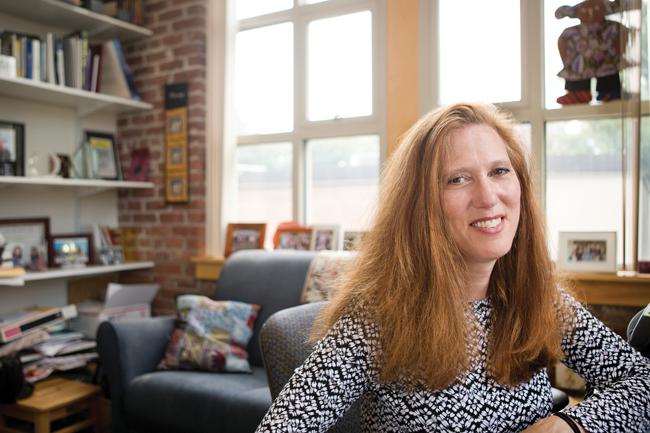How Are You?
Whether occurring over the fence or in the clinic, conversation requires perceiving the subtleties of voice and body
- 8 minute read
- Feature
Words alone don’t tell tales. When we speak, we use tone, cadence, and body language to telegraph nuances of meaning to others. While words are essential to conveying the message, it’s the nonverbal qualities of communication that convey emotional states, the subtext. In fact, research has shown that most of our emotional communication is done nonverbally through facial expressions, gaze, gesture, posture, and tone of voice. In communication, the supporting cast is just as important as the star.
To appreciate—and complete—what’s being said, there must be a listener, preferably one who is attentive and responsive to both the meaning of words and the subtleties of voice and body. It’s hard to think of a context where the presence of an active listener is of greater moment than in the doctor’s office. What does it mean to listen to the illness, and how do the tonal qualities of a patient’s, and a physician’s, voice contribute to diagnosis and treatment?
Prismatic Perspectives
Because it’s so essential to social functioning, the human voice has been called the most important sound in our environment. From birth, our brains are programmed to respond to characteristics of the human voice, such as tone, pitch, and loudness. Tone of voice shifts as the brain’s limbic system processes emotional states such as anger, fear, happiness, and sadness, as well as mood. Vocal tone can also convey social meaning, for instance, sarcasm or deference.
A recent study in the Journal of Clinical Rheumatology involving an ethnically diverse group of patients with rheumatoid arthritis investigated how tone of voice, of both physicians and patients, in clinical encounters affected treatment adherence. The researchers found that although physicians and patients reciprocated one another’s affect, a physicians’ affect, positive or negative, had no effect on treatment adherence, except in one group.
In a group of Hispanic patients, a physician’s negative affect was associated with greater treatment compliance at three months when compared with non-Hispanic white patients. When analyzing this result, the researchers speculated that patients interpreted a negative affect as indicating greater concern for their health, which may have then motivated their adherence to treatment.

Patients’ tone of voice carried more weight in compliance measures, as patients with poor treatment adherence exhibited a more distressed affect at baseline and at three months than patients with more positive affect.
This finding of what might be considered affective symbiosis speaks to the idea that the clinical encounter works best when the parties involved find a level of understanding. As Francis Weld Peabody, Class of 1907, wrote in the early twentieth century, “unless there is complete confidence in the sympathetic understanding of the physician as well as in his professional skill, very little can be accomplished.” One way to get to a mutually agreeable understanding is to ask questions and actively engage with the content and tone of the responses.
Dawn DeWitt ’90 would agree. DeWitt, a professor of general internal medicine in the MD Undergraduate Program at the University of British Columbia Faculty of Medicine and former associate dean in the faculties of medicine both at the University of British Columbia and the University of Melbourne, teaches her students to be alert to emotional cues from patients and to develop powers of perception and observation. “I tell them, ‘When you don’t know what’s going on, it’s time to get curious,’ ” she says. “Curiosity is key.” One thing she works on with students is to not let clues drop. “Patients will mention something in the middle of an answer or story,” she adds, “and if you don’t follow up on it, you’re going to miss clues—and cues.”
Silence Is Golden
Increasingly, students are seeing patients earlier in their training, and in primary care settings more than in inpatient settings, which gives them the opportunity to establish longer-term relationships with patients and to get to know them over time.
Helping medical students learn how to listen and what to take notice of is a vocation for Elizabeth Gaufberg, an HMS associate professor of medicine and psychiatry at Cambridge Health Alliance and founding team member of the HMS-Cambridge Integrated Clerkship at the Cambridge Health Alliance.
In her clinical communications skills classes Gaufberg keeps her focus on patient-centered practice by following the Four Habits Model of Highly Effective Clinicians, an approach developed two decades ago and now in use around the United States and abroad. The model, a guide to conducting a collaborative and fruitful clinical interview, is based on four components of a clinical encounter: invest in the beginning, elicit the patient’s perspective, demonstrate empathy, and invest in the end.
As a way of demonstrating empathy, the model suggests that the physician look for changes in the patient’s body language and tone of voice, while reminding the physician to look for opportunities to “use a pause, touch, or facial expression” to let the patient know that he is being heard. Demonstrating empathy, according to the four habits model, helps to build trust, which leads to better treatment adherence and outcomes. There is a role on both sides of the exam table, but the physician, being in a position to serve, bears the greater responsibility of being sensitive and observant.
The idea of using a pause, a silence, in conversation is one of the more difficult skills for students to become comfortable with, says Gaufberg. “In the ‘giving bad news’ exercise, we encourage students to take their cue from a patient’s reaction, to, say, news that he or she has metastatic cancer. Sometimes the reaction is silence. And in our society—not just in medicine—we want to fill up silences. Doctors fill up silences with questions or information instead of just allowing patients to experience whatever they’re experiencing and giving them time to process and express it.”

In teaching the School’s Patient-Doctor II course, Fidencio Saldaña ’01, an HMS assistant professor of medicine at Brigham and Women’s Hospital, works on getting students to feel comfortable with establishing a relationship with the person sitting in front of them by reading body language, interpreting the patient’s tone of voice, and sensing what the person is willing to share. Saldaña describes teaching a case in which the patient comes in with a complaint about headache or abdominal pain, but the underlying problem may not be a physical one. In this exercise, the students are coached to read body language as they attend to the patient’s story about why the patient is seeking care. “This is something we want to make sure our students are very attuned to.”
Advice received during his own years of training has stuck with Saldaña. “One of my mentors always used to ask, ‘Who really is this patient? Where do they work? Who do they live with? What is their life like at this point?’ We want our students to keep these things in mind. Everyone comes in with a culture and a story, and it’s up to us to get a window into what else is going on with them,” he says.
Focal Point
Medicine, of course, is not all emotion and psychology. Physicians go through rigorous training in the science as well as the art of medicine. The evidence-based approach to medicine, which started to gain currency about two decades ago, is now beginning to blend with the traditional approach of patient-centered medicine. This blending, some say, could yield a productive partnership between the scientific and the social.
According to Gaufberg, the seemingly softer approach of patient-centered medicine can contribute to the harder edge of evidence. “It’s more than just being nice,” she says. “Patients show better diabetes control, for example, if their doctors are more empathetic.”
Research published in PLOS ONE in 2014 supports this idea, finding a small but statistically significant beneficial effect of the patient-doctor relationship on several objective or validated subjective health outcomes, such as blood pressure, serum readings, and pain relief. Positive physician behaviors listed in the review include the degree of attention to nonverbal signals, the willingness to listen without interrupting and to sit instead of stand when talking with the patient, and the frequency with which appropriate eye contact is made. An intriguing finding is that communications interventions for physicians that are meant to improve the quality of information exchange, such as asking open-ended questions and checking on patients’ understanding of their diagnosis and treatment plan, also produce richer interpersonal interactions.
A patient-centered approach can put marks in the plus column for physicians, too. “If doctors attend to the relational aspect of medicine and learn to connect and communicate with patients,” Gaufberg says, “they are less likely to burn out. And burnout is linked to other things, like quality of care.”
Even small things can serve to build robust connections. Consider the difference it makes when a doctor turns the computer screen toward a patient, forming what is called “the triangle of trust.” This gesture allows patient and doctor to review the medical record together, thus creating a story about the patient’s life by inviting the patient to co-create her own narrative.
Summarizing the patient’s story, letting her correct it and add to it, affirms that her voice has been heard and her tone and manner understood. With this realization, a bond is formed, an alliance forged. The medical becomes personal through the expression of the patient’s—and the physician’s—voice in the conversation.
Susan Karcz is assistant editor of Harvard Medicine magazine.
Photos: Mattias Paludi (top); John Soares